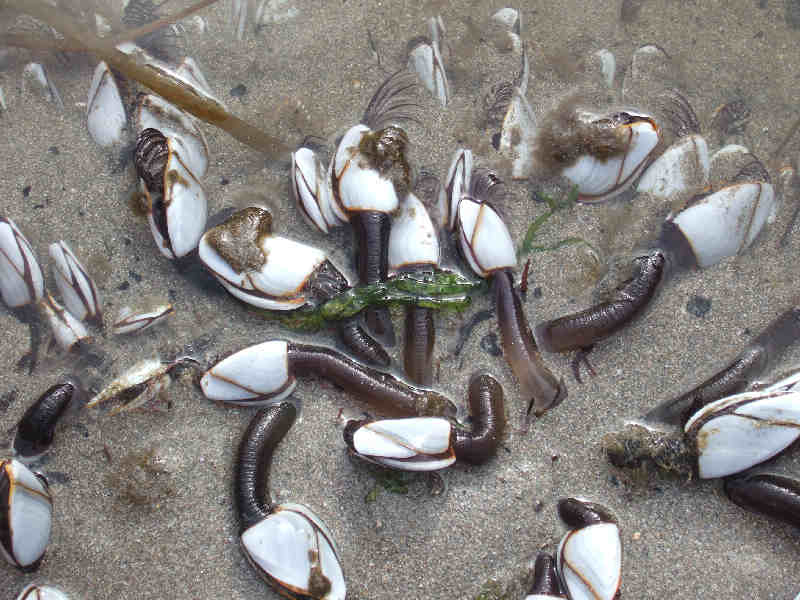Common goose barnacle (Lepas (Anatifa) anatifera)
Distribution data supplied by the Ocean Biodiversity Information System (OBIS). To interrogate UK data visit the NBN Atlas.Map Help
| Researched by | Ken Neal | Refereed by | Admin |
| Authority | Linnaeus, 1758 | ||
| Other common names | - | Synonyms | Lepas anatifera |
Summary
Description
Lepas anatifera is made up of two parts; the capitulum, 4-5 cm long, bears the feeding tentacles and body of the barnacle, and the peduncle, 4-85 cm long, which is a flexible, contractile stalk that attaches the barnacle to floating objects. The capitulum is roughly oblong with five smooth white plates, separated by red/brown or black tissue. If Lepas anatifera is observed underwater, the brush-like feeding appendages may be seen protruding from lower end of the animal.
Recorded distribution in Britain and Ireland
Found washed up on the shore on western coasts of Britain and Ireland especially after westerly gales but poorly recorded in surveys. Rarely found on east coasts of Britain. Otherwise, a pelagic species in the Atlantic and western English Channel.Global distribution
-Habitat
A pelagic species attached to hard floating objects such as logs.Depth range
-Identifying features
- Body divided into two parts: the capitulum which bears the body of the animal and a flexible peduncle.
- Capitulum has five large calcareous plates.
- Plates on the capitulum are smooth or at most finely marked.
Additional information
A guide to the identification of the various species of Lepas is given by Bassindale (1964).
Listed by
- none -
Bibliography
Bassindale, R., 1964. British Barnacles. London: The Linnean Society of London.[Synopses of the British Fauna, no. 14.]
Gibson, R., Hextall, B. & Rogers, A., 2001. Photographic guide to the sea and seashore life of Britain and north-west Europe. Oxford: Oxford University Press.
Hayward, P.J. & Ryland, J.S. 1990. The marine fauna of the British Isles and north-west Europe. Oxford: Oxford University Press.
Howson, C.M. & Picton, B.E., 1997. The species directory of the marine fauna and flora of the British Isles and surrounding seas. Belfast: Ulster Museum. [Ulster Museum publication, no. 276.]
Datasets
Fenwick, 2018. Aphotomarine. Occurrence dataset http://www.aphotomarine.com/index.html Accessed via NBNAtlas.org on 2018-10-01
National Trust, 2017. National Trust Species Records. Occurrence dataset: https://doi.org/10.15468/opc6g1 accessed via GBIF.org on 2018-10-01.
NBN (National Biodiversity Network) Atlas. Available from: https://www.nbnatlas.org.
OBIS (Ocean Biodiversity Information System), 2025. Global map of species distribution using gridded data. Available from: Ocean Biogeographic Information System. www.iobis.org. Accessed: 2025-07-25
Outer Hebrides Biological Recording, 2018. Invertebrates (except insects), Outer Hebrides. Occurrence dataset: https://doi.org/10.15468/hpavud accessed via GBIF.org on 2018-10-01.
South East Wales Biodiversity Records Centre, 2018. SEWBReC Myriapods, Isopods, and allied species (South East Wales). Occurrence dataset: https://doi.org/10.15468/rvxsqs accessed via GBIF.org on 2018-10-02.
Citation
This review can be cited as:
Last Updated: 13/08/2007



